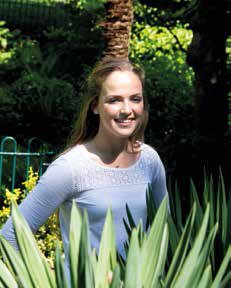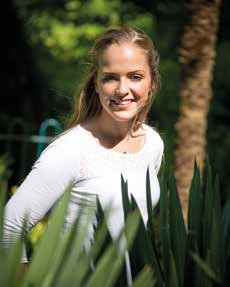articles/Portraiture/posing-page2
Posing People - part 2 of 1 2 3
by Peter Ellis Published 01/10/2016

Watch your background! Move to the right and open your aperture.
Here are just a few basic tips to be aware of:
Your subjects:
• Inexperienced subjects often struggle to know what to do with their hands. Having the arms hanging limply by their sides rarely feels or looks good, slipping them lightly into the top of the trouser will work well for men.
• Crossed arms can also be very effective for some subjects but in others it can portray fear, protection and create a negative barrier between the subject and the viewer.
• Make sure that the hands look relaxed rather than clenched; unless of course you want to convey anxiety or tension. To create a relaxed image it can help to give your subject something to hold or have them touch a nearby prop. If they’re standing behind someone who is seated, they could put their hands on the chair or the other person’s shoulders.
• Watch out for fingers creeping over the shoulder or around the waist. If you have hands in the portrait then check you can see all the fingers.
Remember that photographing people is always difficult because: some subjects have a very strong perception of how they think they should look, normally fuelled by the internet; and some people just hate having their photographs taken because they always think they look awful. It is up to you to manage all this.
Lens choice:
• If you use a wide-angle lens it will make people in the front appear much bigger than those who are further away, they will have an enlarged nose, above a receding chin, on a small face with tiny eyes - not a good look! It’s far more flattering to shoot from a little further away and use a longer lens as this will help keep the sitter’s facial features in proportion.

• As the standard lens on most cameras has a focal length of 50mm, this could be a good starting lens for environmental or even studio portraiture. If you have to shoot the subject in their place of work, something a little longer, say around 85mm, is often regarded as a good choice for head-and-shoulders portraits.
Note: Don’t forget, that a 50mm lens is equivalent to around 75mm on an APS-C format SLR, so your standard prime lens can be an excellent choice.
If you are a Fuji user then the 56mm is an excellent portrait lens for their latest compact system cameras.
• Longer telephoto lenses can work well for you, although you may need to be a fair distance from your subject and this could cause communication problems, also you will probably need more space to work in. Using a telephoto lens has the added advantage of restricting depth of field so the background is more out of focus, putting greater emphasis on your subject.
• As a general rule, the eyes in a portrait image should always be sharp.
Please Note:
There is more than one page for this Article.
You are currently on page 2 Contact Peter Ellis
1st Published 01/10/2016
last update 09/12/2022 14:58:05
More Portraiture Articles
There are 0 days to get ready for The Society of Photographers Convention and Trade Show at The Novotel London West, Hammersmith ...
which starts on Wednesday 15th January 2025





